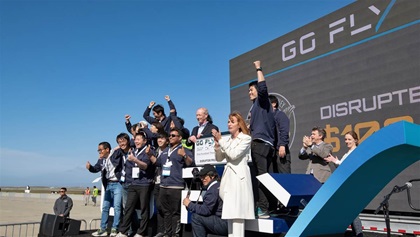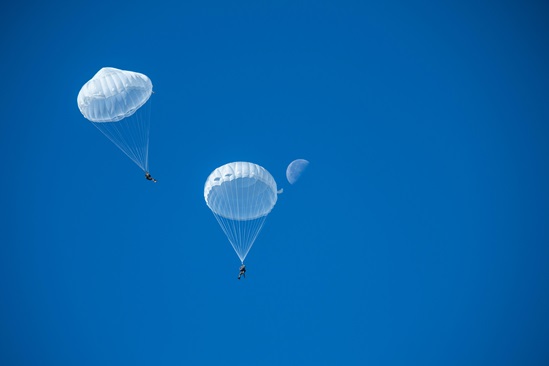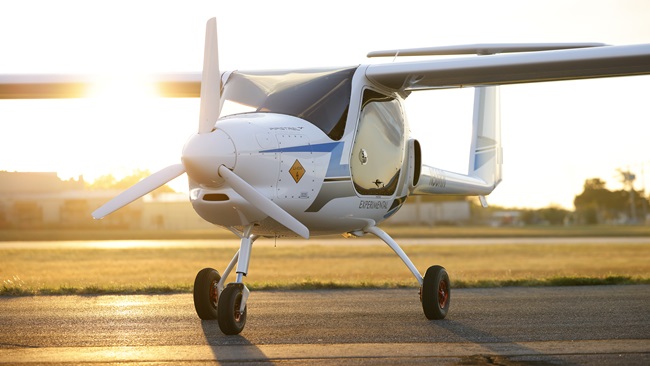Personal eVTOL on the cusp
GoFly Prize fosters innovation in individual transportation
Competing designs




The Zeva Zero—Zeva is for zero emissions, electric, vertical aircraft—combines the best features of a multicopter with a flying-wing body for greater range and efficiency. Its developers envision a personal flying machine that transitions from hover to forward flight and cruises at 160 mph. It was at Moffett Field in late February for what’s now being called the Inaugural GoFly Prize Final Fly Off (see “Eyes on the Prize,” below).
GoFly prize rules require an open-air flight experience that precludes overhead rotor placement. that s why no entries resemble traditional helicopters.
GoFly rules include several design requirements that challenged the teams. For example, the size—defined as the maximum single dimension in any direction between two planes, not including the operator—can be no more than 8.5 feet; components that continually rotate are considered a full disc. The maximum noise is 87 dBA and the minimum speed is 30 knots. And a metric for the “open-air flight experience” prohibits placing rotors over the operator’s head—so no designs resemble traditional helicopters.
Zeva Zero’s four upper propellers are pitched for lift, while the lower props are optimized for level cruise; the prototype has been flying more than a year. As the team learns more, the design evolves. “We went from a 120-volt system to a 240-volt system in two weeks,” because the controllers were failing, team member Steve Brown explained. New motors, with more poles and less resistance, are faster and quieter.
Eyes on the prize








Because variable-pitch propellers are too heavy, Zeva uses eight motors instead of four. “So we end up with redundancy for safety,” explained Andrew Balerud, director of marketing.
“We’re unique in that the blended wing body gives us lift,” Zeva Aero CEO Stephen Tibbitts said. “Being able to fly point to point is very attractive to me.” The Department of Defense and prime contractors have shown interest because “it’s quiet, it has a low heat signature, it can fly low.”
The coronavirus pandemic has delayed their progress since the fly-off, and the team has been making masks and face shields for local medical personnel, but work is advancing on software and battery management. “We’re having issues with the speed controllers and the motors not working together,” Tibbitts said. “Things are coming together. If it was easy, there would be a lot of people doing it.”
“GoFly isn’t our finish line. It’s a lap in our race,” Balerud added. “The long game is urban air mobility but the immediate opportunities more and more appear to be with DOD and EMS.” The technology can be scaled up or down, he noted. “If you scale it down, unmanned, you’re immediately able to deploy lifesaving equipment” such as an automated external defibrillator or EpiPen. “Sometimes it’s good to think small.”
DragonAir Airboard
Although DragonAir Aviation appears to have logged significantly more manned flight time than any other GoFly contender, a hard landing during an airworthiness demonstration earlier in the week disqualified the team from competing in the fly-off. Its Airboard is a one-person eVTOL platform, lifted by eight electric motors; the pilot stands on top.
After a three-day drive to California from Panama City Beach, Florida, “we had a malfunction and a pretty rough landing that took us out of the competition,” explained Mariah Cain, DragonAir CEO, founder, and pilot. She and her team immediately identified the problem, made repairs, then passed a validation flight that would have allowed them to perform a demonstration Saturday—when high winds precluded any flying. She has completed several successful Airboard 2.0 flights since then.
“The GoFly Prize is a great stepping stone, and a great way to get our name out. But it’s not the end game for DragonAir,” Cain said. After GoFly she said she and her team planned to redesign the Airboard and build 10 aircraft. “People have been dreaming of this forever, and [now] the technology is up to par,” Cain said. “There’s still a lot to do. When they need big innovation and big change, there’s risk involved.”
Team Jayu
Ben Sena, a founder of Team Jayu, from the Massachusetts Institute of Technology, flew their quarter-scale model. “This design came to fruition midway through Phase II of GoFly. We’re working on the half scale.” The team combined drone performance with fixed-wing design. “Everything has a use in every stage of flight,” he explained, “although that use might change.” For example, the wing separates the electric motors to provide vertical lift capability, and provides lift in forward flight. “The landing gear serve as landing gear for takeoff and landing, but in flight they serve as stabilizers.” Coaxial propellers provide redundancy and reduce the aircraft’s footprint. “If we have more props we can spin them slower,” providing acoustic and other benefits, Sena said. They plan to scale up to a full-size aircraft, added Soojae Jung, co-founder.
Since the fly-off, Jayu has been focused on fundraising and on recruiting team members. “The pandemic hasn’t helped us,” Sena said, adding that they lost their indoor flight test venue because of the novel coronavirus. “It’s really nice to have an indoor space because you don’t have to worry about the wind, or the weather, or people getting mad that we’re flying something as big as a motorcycle.”
Sena said they’ve been working on simulation of control surfaces, which weren’t in the original design. He said the team wants to validate them at half scale before moving up to a full-size aircraft. That aircraft is expected to cruise at 55 knots; the designers are trying to decide between FAR Part 103 (Ultralight Vehicles) and light sport aircraft approval paths. “I feel we’re going to see the market boom as ultralights, as personal aircraft come into the market.”
teTra Aviation
Tokyo, Japan-based teTra Aviation Corporation—Technology for Transportation—demonstrated its flying bike concept. After an oscillation developed on its first flight, the craft made a hard landing; it did not climb as high on a second flight. The team won the $100,000 Pratt & Whitney Disruptor Award (see “Eyes on the Prize,” right).
Although the grand prize has not been awarded it s clear the competition has accelerated the development of personal eVTOL aircraft.The angles of the four fixed rotors differentiate teTra’s design, making it easier for the aircraft to transition between vertical and forward flight, explained Pritish Tripathy Debasis, an electronics research and development engineer for the team. Two rotors thrust upward, while the other two are angled forward. “It is always flying in both modes,” he said, adding that the design’s wing also provides some lift, increasing efficiency in forward flight.
“Personal flying is the future of transportation and I know there will be a day when every person will be able to take off and land anywhere,” said Tasuku Nakai, team captain and a University of Tokyo doctoral student.
Harmony Aeronautics
Harmony Aeronautics, which evolved from Texas A&M University’s Advanced Vertical Flight Laboratory, demonstrated a scale model of its Aria at GoFly. “The big one is 500 pounds. We did forward flight tests—it flies beautifully. We were flying it last week and had an accident,” co-founder and COO Farid Saemi explained. Several components needed repair, and the task would take several weeks.
Aria’s propeller configuration, with coaxial rotors and counterrotating blades located below the open cabin, helps to quiet the sound of the props—reducing it from a loud buzz to a low-frequency hum. “Going forward we’re going to bring the rotor overhead and enclose the person,” Saemi said.
“We really want to take this design to the next level,” said Noble Benedict, assistant professor of aerospace engineering. “It has to be small. It has to be efficient. And you want to take off without making noise. We want this to be really quiet.”
“This thing is quiet,” Saemi noted. “Everybody is going after eVTOL but it sounds like a swarm of angry bees. You don’t want a swarm of bees taking off from your backyard.”
“The rotor gets more efficient as it gets bigger,” explained Carl Runco. “So we took GoFly’s 8-and-a-half foot requirement and filled it with rotor.” The optimal rotor diameter for an aircraft of this size would be 10 to 15 feet, he added.
An extra 10 to 20 percent in rotor diameter makes a big difference, Hunter Denton said. “In a helicopter it’s the outer 75 percent of the rotor that produces the majority of the lift.” Having two rotors of the same size allow for a lower tip speed, which is critical to reducing the sound’s frequency. “The higher the frequency, the louder humans perceive the noise,” he said, while lower frequencies are perceived as quieter. “That matters more than the number.”
“We’re going to try to use this as a springboard to future development,” Runco explained. “Over the next decade we see personal flying vehicles being accepted into a light sport category of recreational vehicles.”
Since the fly-off, Saemi said the team members—mostly grad students—have been catching up on their individual research. “However, we’ve also been applying for Army and Air Force small business proposals.” The coronavirus pandemic has affected Harmony’s efforts, as well. “We are a university team in Texas, so one reason why we haven’t worked on hardware is because of stay-at-home orders and university shutdowns.”
Trek Aerospace FK2
“We sell ducted props. That’s what our business is. We think of this as a technology demonstrator,” said Jose Fierro, vice president of operations and business development for Trek Aerospace. “We’re really agnostic about what powers the ducted fans.”
Trek showed its Version 2.4 at GoFly, which it started building only 30 days earlier. Going from Version 2.1 to 2.4, Trek cut weight by 12 percent; went from 10 to 12 ducted fans, increasing redundancy and allowing the blades to turn at slower speeds; added batteries; and made the airframe more rigid.
“With this one we ostensibly could lose three [fans], not all on one side, and still maintain controllability,” Fierro said. The aircraft, which is designed to carry a 200-pound person, had not flown as of late February.
Concept Aircraft AirCycle
Anthony Windisch has been working on his Concept Aircraft LLC’s AirCycle design for 34 years. He sourced many components for his unique design from home improvement stores. The hood ornament—yes, it has a hood ornament—was bought online through Amazon. The Aircycle is a small VTOL aircraft designed to transport a single pilot beyond 20 miles, land at unprepared locations, and exhibit balanced control in all flight regimes.
The Aircycle hasn’t flown; finding a flight computer to control the thrusters has been a challenge. “They haven’t been fast enough,” he said. Its industrial engine has been hopped up using go-kart customization techniques so that it produces 34 horsepower instead of 22. When it does fly, Windisch has no idea how high his aircraft will go. He said first flight could occur this year, and his wife’s encouraging him to do so. “She has a million-dollar life insurance policy [on me] and she encourages me to flight test immediately,” he laughed.
Going forward
The GoFly challenge drew 854 teams comprising more than 3,800 innovators from 103 countries. Designs run the gamut from flying cars, flying motorcycles, and hoverboards to human-carrying drones. Some teams are self-funded, and others have venture capital assistance.
Although the grand prize has not yet been awarded, it’s clear that the competition has accelerated the development of technology supporting personal eVTOL aircraft. Many teams said lessons learned from testing earlier iterations led to significant design changes during GoFly’s final phase, and several plan revisions beyond competition requirements.
Email [email protected]

 About 20 eVTOL aircraft design teams gathered in late February at NASA’s Moffett Federal Airfield in Mountain View, California, for what’s now being called the Inaugural GoFly Prize Final Fly Off. The GoFly Prize was founded to foster the development of safe, quiet, compact, near-VTOL personal flying devices capable of carrying a single person 20 miles, explained Gwen Lighter, GoFly founder and CEO. The prize is supported by Boeing, the grand prize sponsor; Pratt & Whitney, the Disruptor Award sponsor; and more than 20 national and international aviation and innovation organizations.
About 20 eVTOL aircraft design teams gathered in late February at NASA’s Moffett Federal Airfield in Mountain View, California, for what’s now being called the Inaugural GoFly Prize Final Fly Off. The GoFly Prize was founded to foster the development of safe, quiet, compact, near-VTOL personal flying devices capable of carrying a single person 20 miles, explained Gwen Lighter, GoFly founder and CEO. The prize is supported by Boeing, the grand prize sponsor; Pratt & Whitney, the Disruptor Award sponsor; and more than 20 national and international aviation and innovation organizations. 

